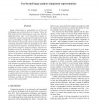Free Online Productivity Tools
i2Speak
i2Symbol
i2OCR
iTex2Img
iWeb2Print
iWeb2Shot
i2Type
iPdf2Split
iPdf2Merge
i2Bopomofo
i2Arabic
i2Style
i2Image
i2PDF
iLatex2Rtf
Sci2ools
CVPR
2008
IEEE
2008
IEEE
Geo-located image analysis using latent representations
Image categorization is undoubtedly one of the most challenging open problems faced in Computer Vision, far from being solved by employing pure visual cues. Recently, additional textual "tags" can be associated to images, enriching their semantic interpretation beyond the pure visual aspect, and helping to bridge the so-called semantic gap. One of the latest class of tags consists in geo-location data, containing information about the geographical site where an image has been captured. Such data motivate, if not require, novel strategies to categorize images, and pose new problems to focus on. In this paper, we present a statistical method for geo-located image categorization, in which categories are formed by clustering geographically proximal images with similar visual appearance. The proposed strategy permits also to deal with the geo-recognition problem, i.e., to infer the geographical area depicted by images with no available location information. The method lies in the...
Computer Vision | CVPR 2008 | Geo-located Image Categorization | Latent Semantic Analysis | Pure Visual Aspect | Statistical Latent Representations | Well-known Geographical Image |
| Added | 12 Oct 2009 |
| Updated | 12 Oct 2009 |
| Type | Conference |
| Year | 2008 |
| Where | CVPR |
| Authors | Marco Cristani, Alessandro Perina, Umberto Castellani, Vittorio Murino |
Comments (0)

